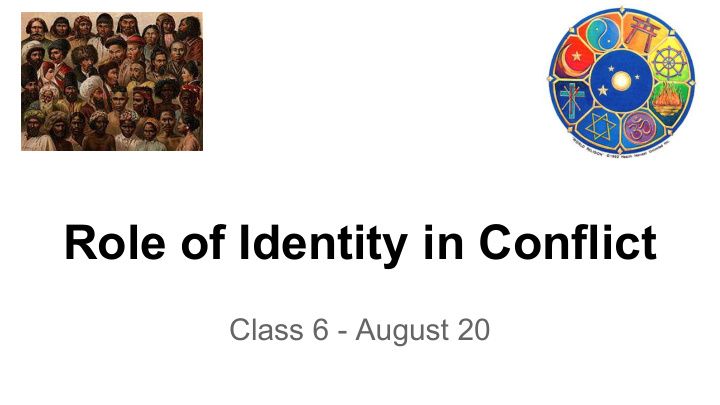



Role of Identity in Conflict Class 6 - August 20
Definition of identity ● Aspects or attributes of a person. ○ Categorizable in society. ● Types of categories: ○ Ethnicity. ○ Religion. ○ Class ○ Organization membership. ○ City of birth.
Types of identity (Fearon) Role vs. Type Personal vs. Social. Both categories overlap and categorizations influence one another.
Janus Face Model (Laitin) ● Some aspects of identity are fixed: ○ Skin color, language, place of birth, culture. ● Others are changeable: ○ Race, religion, class, etc. ● People can choose to highlight one characteristic over others.
Identity helps people overcome collective action and coordination problems. ● Social ties reveal preferences. ● Denser social networks apply pressure to group members.
In-group closeness = out-group threat ● Social proximity leads to distrust of outsiders. ● Similarly, outsiders can start to distrust in-group because of social proximity. ● -->>> Conflict
Three ways to view identity and conflict: ● Essentialist (Horowitz, Geertz) ● Instrumentalist/Institutionalist (Brass, Bates, King) ● Constructivist (Wilkinson, Posner, Kalyvas)
Essentialist Perspective ● Identity characteristics, particularly ethnicity, are ingrained into collective consciousness. ● Ethnicity ingrains three characteristics: ○ Affectivity ○ A priori ○ Ineffability ● Fixed in the short term, difficult to change in long term.
Ethnicity shapes interactions ● Ethnic distinctions shape economic, political and social competition. ● Co-ethnics are more likely to interact with one another, less likely with non-co-ethnics.
Horizontal Inequality drives conflict Advanced groups : empowered by colonial authorities, wealthy, educated, hold political power and civil service jobs “Backward” groups: disempowered by colonial authorities, poor, uneducated, no political power or civil service jobs.
Horizontal Inequality leads to conflict ● Both disempowered advanced and backward groups can seek secession. ● Neighboring states can try to annex disempowered co-ethnics across borders. ○ Think Russia and Ukraine.
Instrumentalist/Institutionalist View ● Shared history of identity is irrelevant. ● Conflict occurs when politicians or entrepreneurs exploit identity divisions to empower themselves. Institutionalists: Same, through political institutions.
Bates: Traditional leaders enhance bonds for profit ● Leaders use identity to profit as societies urbanize. ● The identity they highlight is purely opportunistic.
King: Institutions exploited for conflict ● What conflicts does King talk about?
King: Institutions exploited for conflict ● What conflicts does King talk about? ○ Former Soviet secessionist conflicts ○ What do they have in common?
Growth of National Sentiment: ● Dependent on pre-existing political institutions established by USSR. ● Myths built by politicians after de facto independence solidify separatism. ● How would Horowitz explain the movements?
Constructivist View Wilkinson, to an extent + Dan Posner. ● Identities are fixed, but overlap (cross-cut). These overlaps can be exploited for political gain or change based on political factors.
Posner: Cleavage salience in Africa ● Chewas and Tumbukas are allies in Malawian politics, adversaries in Zambia. ○ Depends on relative group size. ● Tribal affinity more relevant when Zambia was a one-party state, ethnic identity when a democracy. ○ Depends on whether local or national elections matter more.
Discussion: What school is more plausible to you? Does conflict start because of unchanged historical rivalries or is it used as a fluid tool by opportunists?
Serbs in Croatia Identity Case
Background: Yugoslavia ● Kingdom of South Slavs created after WWI. ● Communist dictatorship under Josip Broz Tito. ○ Tito dies in 1980.
Central Government challenged in 1980s. ● Nationalists seize governments of each component of Yugoslavia. ● Slobodan Milosevic attempts to govern Yugoslavia as a Serbian dominated country.
How does crisis begin?
How does crisis begin? ● Serb paramilitaries formed to put down protests in Kosovo. ○ Recruit soccer hooligans, criminals and thugs to participate in militias. ● Milosevic gains power in 1989. ● Four constituent states of Yugoslavia seek independence.
Lead-up to war ● Croatian nationalists win local elections. ● Serb media emphasizes WWII-era genocide. ● Paramilitaries enter Serb areas and inflame tensions.
Why were paramilitaries used?
Why were paramilitaries used? ● Take pressure off of regular army ○ Do what army wouldn’t do. ● Compel Serbs to rise up against Croatia. ● Lack of USSR support encouraged Greater Serbia plan. ● Gains were institutionalized in 1992 Vance Plan...until Croatians overran Serbian Krajina in 1995.
Given Croatia, which school seems more valid? Does the essentialist explanation have any value? Which conflict does it apply to, if any? Think back to South Sudan, Syria, Northern Ireland, Chechnya or Nigeria.
Recommend
More recommend